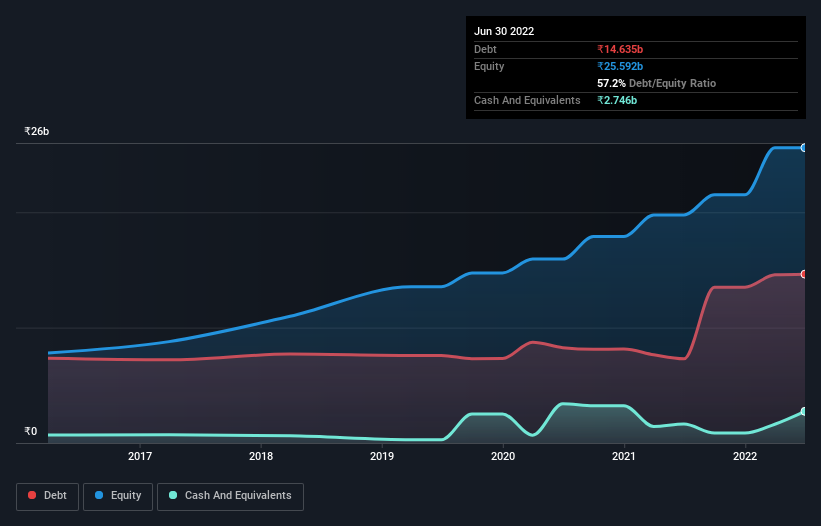The external fund manager backed by Berkshire Hathaway's Charlie Munger, Li Lu, makes no bones about it when he says 'The biggest investment risk is not the volatility of prices, but whether you will suffer a permanent loss of capital.' So it seems the smart money knows that debt - which is usually involved in bankruptcies - is a very important factor, when you assess how risky a company is. We can see that KNR Constructions Limited (NSE:KNRCON) does use debt in its business. But the real question is whether this debt is making the company risky.
When Is Debt A Problem?
Generally speaking, debt only becomes a real problem when a company can't easily pay it off, either by raising capital or with its own cash flow. In the worst case scenario, a company can go bankrupt if it cannot pay its creditors. However, a more common (but still painful) scenario is that it has to raise new equity capital at a low price, thus permanently diluting shareholders. Of course, plenty of companies use debt to fund growth, without any negative consequences. The first step when considering a company's debt levels is to consider its cash and debt together.
See our latest analysis for KNR Constructions
How Much Debt Does KNR Constructions Carry?
You can click the graphic below for the historical numbers, but it shows that as of March 2022 KNR Constructions had ₹14.6b of debt, an increase on ₹7.29b, over one year. However, because it has a cash reserve of ₹2.75b, its net debt is less, at about ₹11.9b.

How Healthy Is KNR Constructions' Balance Sheet?
The latest balance sheet data shows that KNR Constructions had liabilities of ₹12.6b due within a year, and liabilities of ₹14.5b falling due after that. On the other hand, it had cash of ₹2.75b and ₹9.50b worth of receivables due within a year. So its liabilities outweigh the sum of its cash and (near-term) receivables by ₹14.9b.
While this might seem like a lot, it is not so bad since KNR Constructions has a market capitalization of ₹64.1b, and so it could probably strengthen its balance sheet by raising capital if it needed to. However, it is still worthwhile taking a close look at its ability to pay off debt.
In order to size up a company's debt relative to its earnings, we calculate its net debt divided by its earnings before interest, tax, depreciation, and amortization (EBITDA) and its earnings before interest and tax (EBIT) divided by its interest expense (its interest cover). Thus we consider debt relative to earnings both with and without depreciation and amortization expenses.
While KNR Constructions's low debt to EBITDA ratio of 1.5 suggests only modest use of debt, the fact that EBIT only covered the interest expense by 3.7 times last year does give us pause. So we'd recommend keeping a close eye on the impact financing costs are having on the business. KNR Constructions grew its EBIT by 6.6% in the last year. That's far from incredible but it is a good thing, when it comes to paying off debt. There's no doubt that we learn most about debt from the balance sheet. But you can't view debt in total isolation; since KNR Constructions will need earnings to service that debt. So if you're keen to discover more about its earnings, it might be worth checking out this graph of its long term earnings trend.
But our final consideration is also important, because a company cannot pay debt with paper profits; it needs cold hard cash. So the logical step is to look at the proportion of that EBIT that is matched by actual free cash flow. During the last three years, KNR Constructions burned a lot of cash. While that may be a result of expenditure for growth, it does make the debt far more risky.
Our View
KNR Constructions's conversion of EBIT to free cash flow was a real negative on this analysis, although the other factors we considered cast it in a significantly better light. But on the bright side, its ability to handle its debt, based on its EBITDA, isn't too shabby at all. Taking the abovementioned factors together we do think KNR Constructions's debt poses some risks to the business. So while that leverage does boost returns on equity, we wouldn't really want to see it increase from here. There's no doubt that we learn most about debt from the balance sheet. However, not all investment risk resides within the balance sheet - far from it. Be aware that KNR Constructions is showing 2 warning signs in our investment analysis , and 1 of those is potentially serious...
If you're interested in investing in businesses that can grow profits without the burden of debt, then check out this free list of growing businesses that have net cash on the balance sheet.
Valuation is complex, but we're here to simplify it.
Discover if KNR Constructions might be undervalued or overvalued with our detailed analysis, featuring fair value estimates, potential risks, dividends, insider trades, and its financial condition.
Access Free AnalysisHave feedback on this article? Concerned about the content? Get in touch with us directly. Alternatively, email editorial-team (at) simplywallst.com.
This article by Simply Wall St is general in nature. We provide commentary based on historical data and analyst forecasts only using an unbiased methodology and our articles are not intended to be financial advice. It does not constitute a recommendation to buy or sell any stock, and does not take account of your objectives, or your financial situation. We aim to bring you long-term focused analysis driven by fundamental data. Note that our analysis may not factor in the latest price-sensitive company announcements or qualitative material. Simply Wall St has no position in any stocks mentioned.
About NSEI:KNRCON
KNR Constructions
Engages in the construction, engineering, and infrastructure development activities in India.
Excellent balance sheet with proven track record.
Similar Companies
Market Insights
Community Narratives



